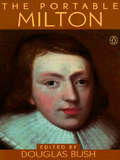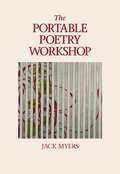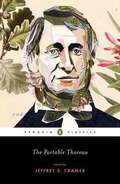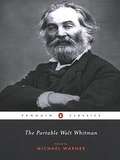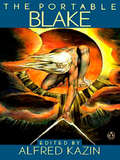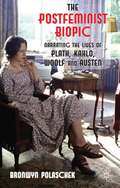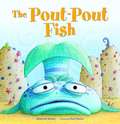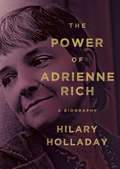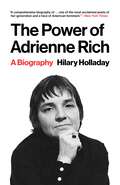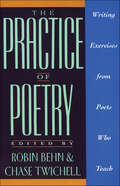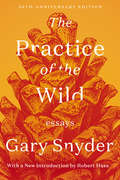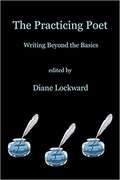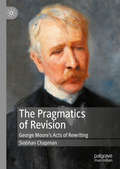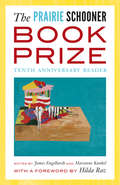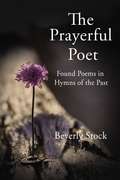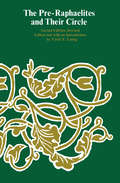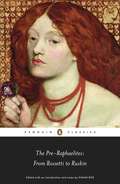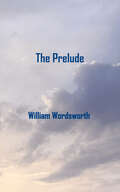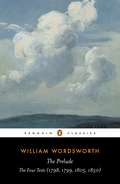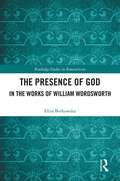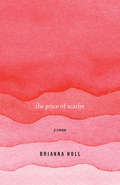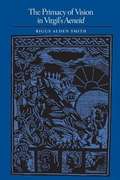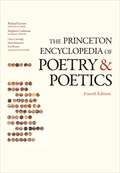- Table View
- List View
The Portable Harlem Renaissance Reader
by David LewisShort selections from the prominent writers of this movement.
The Portable Milton
by John Milton Douglas BushThe Portable Milton is an authoritative grand tour through the imagination of this prodigal genius. <P><P>In the course of his forty-year career, John Milton evolved from a prodigy to a blind prophet, from a philosophical aesthete to a Puritan rebel, and from a poet who proclaimed the triumph of reason to one obsessed with the intractability of sin. Throughout these transformations, he conceived his work as a form of prayer, written in the service of the supreme being.
The Portable Poetry Workshop
by Jack MyersThis "breakthrough" book clearly, comprehensively, and practically informs any student of poetry about the techniques of their craft using the workshop method.
The Portable Thoreau
by Henry David Thoreau Jeffrey S. CramerHenry David Thoreau dedicated his life to preserving his freedom as a man and an artist. Nature was the fountainhead of his inspiration and his refuge from what he considered the follies of society. Heedless of his friends’ advice to live in a more orthodox manner, he determinedly pursued his own inner bent, which was that of a poet-philosopher, in prose and verse. Carl Bode brings together the best of Thoreau’s works in The Portable Thoreau, a comprehensive collection of the writings of a unique and profoundly influential American thinker. The complete texts of Thoreau’s classic works Walden and “Civil Disobedience,” as well as selections from The Maine Woods, Cape Cod, the Journal, and eighteen poems are included. Bode’s introduction rounds out this compact volume, offering a thorough and informative analysis of Thoreau and the forces that shaped his life and writing. “This compact book, containing infinite riches in a little room, is a simple setting for sound sense, nugget-like thought, the refined essences of a point of view” — St. Louis Post-Dispatch .
The Portable Walt Whitman
by Walt Whitman Michael WarnerWhen Walt Whitman self-published Leaves of Grass in 1855 it was a slim volume of twelve poems and he was a journalist and poet from Long Island, little-known but full of ambition and poetic fire. To give a new voice to the new nation shaken by civil war, he spent his entire life revising and adding to the work, but his initial act of bravado in answering Ralph Waldo Emerson's call for a national poet has made Whitman the quintessential American writer. This rich cross-section of his work includes poems from throughout Whitman's lifetime as published on his deathbed edition of 1891, short stories, his prefaces to the many editions of Leaves of Grass, and a variety of prose selections, including Democratic Vistas, Specimen Days, and Slang in America. .
The Portable William Blake
by William BlakeIncludes Songs of Innocence and Songs of Experience complete; the best of the "prophetic books"; a selection of his other great lyrics; representative prose pieces from A Descriptive Catalogue, Public Address and A Vision of the Last Judgement; complete drawings for the Book of Job; and selected letters.
The Postfeminist Biopic
by Bronwyn PolaschekThis book contributes to the growing literature on the biopic genre by outlining and exploring the conventions of the postfeminist biopic. It does so by analyzing recent films about the lives of famous women including Sylvia Plath, Frida Kahlo, Virginia Woolf and Jane Austen.
The Pout-Pout Fish
by Deborah DiesenDeep in the water, Mr. Fish swims about With his fish face stuck In a permanent pout. Can his pals cheer him up? Will his pout ever end? Is there something he can learn From an unexpected friend? Swim along with the pout-pout fish as he discovers that glum isn't really his destiny. Bright ocean colors and playful rhyme come together in this fun fish story that's sure to turn even the poutiest of frowns upside down.
The Power of Adrienne Rich: A Biography
by Hilary HolladayThe first comprehensive biography of Adrienne Rich, feminist and queer icon and internationally revered National Book Award winning poet.Adrienne Rich was the female face of American poetry for decades. Her forceful, uncompromising writing has more than stood the test of time, and the life of the woman behind the words is equally impressive. Motivated by personal revelations, Rich transformed herself from a traditional, Radcliffe-educated lyric poet and married mother of three sons into a path-breaking lesbian-feminist author of prose as well as poetry. In doing so, she emerged as both architect and exemplar of the modern feminist movement, breaking ranks to denounce the male-dominated literary establishment and paving the way for the many queer women of letters to take their places in the cultural mainstream. Drawing on a wealth of unpublished materials, including Rich's correspondence and in-depth interviews with numerous people who knew her, Hilary Holladay digs deep into never-before-accessed sources to portray Rich in full dimension and vivid, human detail.
The Power of Adrienne Rich: A Biography
by Hilary HolladayA New York Times Book Review Editors&’ Choice&“A comprehensive biography of . . . one of the most acclaimed poets of her generation and a face of American feminism.&”—New York TimesA major American writer, thinker, and activist, Adrienne Rich (1929–2012) transformed herself from a traditional, Radcliffe-educated lyric poet and married mother of three sons into a path-breaking lesbian-feminist author of forceful, uncompromising prose as well as poetry. In doing so, she emerged as an architect and exemplar of the feminist movement, breaking ranks to denounce the male-dominated literary establishment and paving the way for women writers to take their places in the cultural mainstream. Drawing on a wealth of unpublished materials, including Rich&’s correspondence and in-depth interviews with many people who knew her, Hilary Holladay provides a vividly detailed, full-dimensional portrait of a woman whose work and life continue to challenge and inspire new generations.
The Practice of Poetry: Writing Exercises From Poets Who Teach
by Robin Behn and Chase TwichellA distinctive collection of more than 90 effective poetry-writing exercises combined with corresponding essays to inspire writers of all levels.The Practice of Poetry is the first handbook for poets to combine poetry-writing exercises with illuminating personal essays by each contributor. The editors, Robin Behn and Chase Twichell, who are themselves poets and teachers of creative writing, have collected more than ninety tested and proven exercises intended for poets enrolled in writing programs or working on their own.Poetry, like any art, is best mastered through practice and, as Behn and Twichell point out in their introduction, “A good exercise serves as a scaffold . . . [and] helps you think about, articulate, and solve specific creative problems.” The exercises in The Practice of Poetry addresses a broad range of topics: the struggle from inspiration, transforming memory and experience into writing, the process of revision, experimenting with formal structure, as well as many others. The result is a comprehensive, distinctive collection of exciting exercises that stimulate the imagination and increase technical flexibility and control.The Practice of Poetry offers poets a chance to sample the best creative-writing techniques being taught in programs around the country and will prove an unlimited resource for any poet writing today.
The Practice of the Wild: Essays
by Gary SnyderGary Snyder has been a major cultural force in America for five decades. Future readers will come to see this book as one of the central texts on wilderness and the interaction of nature and culture. The nine essays in Practice of the Wild reveal that " . . . before ecology became a household work, Snyder understood things about our civilization and economy that no one else was talking about, and he writes about them with great authority and a sinewy line." (The Nation) Snyder has gone on to become one of America's cultural leaders, as his thought has ranged from political and spiritual matters to matters regarding the environment and the art of becoming native to this continent.
The Practicing Poet: Writing Beyond The Basics
by Diane LockwardOrganized into ten sections with each devoted to a poetic concept, The Practicing Poet begins with "Discovering New Material," "Finding the Best Words," "Making Music," "Working with Sentences and Line Breaks," "Crafting Surprise," and "Achieving Tone." The concepts become progressively more sophisticated, moving on to "Dealing with Feelings," "Transforming Your Poems," and "Rethinking and Revising." The final section, "Publishing Your Book," covers manuscript organization, book promotion, and presentation of a good public reading. The book includes thirty brief craft essays, each followed by a model poem and analysis of the poem's craft, then a prompt based on the poem. Ten recyclable bonus prompts are also included. Ten Top Tips lists are each loaded with poetry wisdom from an accomplished poet. The Practicing Poet pushes poets beyond the basics and encourages the continued reading, learning, and writing of poetry. It is suitable as a textbook in the classroom, a guidebook in a workshop, or an at-home tutorial for the practicing poet working independently. The craft essays, poems, and top tips lists include the work of 113 contemporary poets.
The Pragmatics of Revision: George Moore’s Acts of Rewriting
by Siobhan ChapmanThis book presents the first full-length study of the stylistically experimental and influential novelist George Moore’s (1852-1933) repeated acts of rewriting. Moore extensively and repeatedly revised and re-issued many of his major works, sometimes years or even decades after they were initially published. This monograph provides new insights into how this process shaped and determined his work, and by extension into the creative significance of literary rewriting more generally. It also offers the first sustained application of linguistic pragmatics, the study of meaning in interaction, to the work of a single author, opening up questions about how analytical paradigms developed in pragmatics can explain how rewriting can affect the interactive relationship between a literary text and its readers. The book will be of interest to students and researchers in the areas of pragmatics, stylistics, literary history, English literature and Irish literature.
The Prairie Schooner Book Prize: Tenth Anniversary Reader
by James Engelhardt Marianne KunkelAfter ten years of selecting great books from writers, new and established, Prairie Schooner celebrates the first decade of its Book Prize series by offering this collection of excerpts from each year&’s winners in fiction and poetry. Writers such as Brock Clarke, Anne Finger, Rynn Williams, and Paul Guest open windows to ordinary and fantastic experience showcasing the liveliness and power of contemporary literature. Greg Hrbek&’s darkly comic, genre-bending tales stand alongside Ted Gilley&’s stories about achieving bliss through pain and John Keeble&’s reflections on community and the difficulty of love. Here Shane Book&’s poems serve as an elegiac witness to suffering, while Kathleen Flenniken&’s poems consider ordinary women constructing their own significance, and Kara Candito&’s explore sex, loss, and human passions.Whether the topic is fantastic or quotidian, childbirth or monsters, South American airplane disaster or suburban Wisconsin, this writing carries us to the furthest reaches of human experience.
The Prayerful Poet: Found Poems In Hymns of the Past
by Beverly StockBeverly Stock is a feature writer turned poet from St. Louis, Missouri. Noted for her whimsical, thoughtful style, Beverly is passionate about creating work that explores the joys, challenges, and surprises of everyday life. The Prayerful Poet is her first collection of verse. Brimming with joy, wonder, and tenderness, this stirring volume takes inspiration from traditional Christian hymns and classic spiritual works.Each poem combines Beverly’s poetic adaptations with the time-honored hymnal lyrics and finds fresh meaning in traditional songs of praise. A mixture of grand voices and elegiac laments, The Prayerful Poet engages readers with its hopeful perspective, and is a perfect read for anyone who finds beauty in the divine.
The Pre-Raphaelites and Their Circle
by Cecil Y. LangThis useful volume presents the major works of the five leading Pre-Raphaelite poets. Foremost in the collection, and included in their entirety are D. G. Rossetti's The House of Life, C. G. Rossetti's "Monna Innominata," William Morris's "Defence of Guenevere," Swinburne's Atalanta in Calydon, and Meredith's "Modern Love." Complementing these major poems is a fine, generous selection of the poets' shorter pieces that are typical of their work as a whole. For this second edition, Cecil Lang has substituted two early Swinburne poems, "The Leper" and "Anactoria," for Fitzgerald's The Rubáiyát of Omar Khayyám. These poems, which the editor describes as "shocking," show a new aspect of Swinburne not discussed previously. Lang's Introduction describes briefly the founding of the Pre-Raphaelite Brotherhood, discusses each of the Pre-Raphaelite poets, both individually and in relation to the others, and grapples with the questions of definition of Pre-Raphaelitism and the similarities between its painting and poetry. The book is appropriately illustrated with thirty-two works by D. G. Rossetti, John Ruskin, William H. Hunt, and other Pre-Raphaelite artists. This is the only anthology available that provides a representative selection of the work of these important poets. It will be indispensable to students of Victorian poetry and appreciated by readers interested in the Pre-Raphaelites.
The Pre-Raphaelites: From Rossetti to Ruskin
by Dinah RoeThe Pre-Raphaelite Movement began in 1848, and experienced its heyday in the 1860s and 1870s. Influenced by the then little-known Keats and Blake, as well as Wordsworth, Shelley and Coleridge, Pre-Raphaelite poetry 'etherialized sensation' (in the words of Antony Harrison), and popularized the notion ofl'art pour l'art - art for art's sake. Where Victorian realist novels explored the grit and grime of the Industrial Revolution, Pre-Raphaelite poems concentrated on more abstract themes of romantic love, artistic inspiration and sexuality. Later they attracted Aesthetes and Decadents like Oscar Wilde, Aubrey Beardsley and Ernest Dowson, not to mention Gerard Manley Hopkins and W.B. Yeats.
The Prelude
by William WordsworthThe Prelude or, "Growth of a Poet's Mind; An Autobiographical Poem" is an autobiographical epic poem by the English poet William Wordsworth. Intended as the introduction to the more philosophical Recluse, which Wordsworth never finished, The Prelude is an extremely personal and revealing work on the details of Wordsworth's life. Wordsworth began 'The Prelude in 1798 at the age of 28 and continued to work on it throughout his life. The Prelude was eventually published posthumously in 1850 by Wordsworth's wife, Mary Wordsworth.William Wordsworth (7 April 1770 - 23 April 1850) was a major English Romantic poet who, with Samuel Taylor Coleridge, helped to launch the Romantic Age in English literature with the 1798 joint publication - Lyrical Ballads. His magnum opus is generally considered to be The Prelude. Wordsworth was Britain's Poet Laureate from 1843 until his death in 1850.
The Prelude: The Four Texts (1798, 1799, 1805, 1850) (Chinese Studies #No. 35)
by William WordsworthFirst published in July 1850, shortly after Wordsworth's death, The Prelude was the culmination of over fifty years of creative work. The great Romantic poem of human consciousness, it takes as its theme 'the growth of a poet's mind': leading the reader back to Wordsworth's formative moments of childhood and youth, and detailing his experiences as a radical undergraduate in France at the time of the Revolution. Initially inspired by Coleridge's exhortation that Wordsworth write a work upon the French Revolution, The Prelude has ultimately become one of the finest examples of poetic autobiography ever written; a fascinating examination of the self that also presents a comprehensive view of the poet's own creative vision.
The Presence of God in the Works of William Wordsworth (Routledge Studies in Romanticism)
by Eliza BorkowskaApproaching Wordsworth’ writings from perspectives which have not been considered in critical literature, this book offers a multiangled reflection on the technicalities of the poet’s religious discourse, including the methodology of The Prelude revision, or Wordsworth’s patent art of "pious postscripts." The book constitutes a self-contained whole and can be read independently. Simultaneously, it creates an unusual duet with The Absent God in The Works of William Wordsworth, whose six chapters follow this book’s eight chapters like a sestet which complements the octave—becoming, thus, a tribute to Wordsworth as one of the most prolific sonneteers in history. Both monographs build their theses on Wordsworth’s entire oeuvre and embrace the whole of his wide lifespan. Their completion in 2020 coincides with several round anniversaries: the 250th anniversary of Wordsworth’s birth, the 200th anniversary of The River Duddon, and the 170th anniversary of the publication of his autobiographical masterpiece, The Prelude.
The Price of Scarlet: Poems (University Press of Kentucky New Poetry & Prose Series)
by Brianna NollA debut collection of poetry combining the scientific and the fantastic with Japanese culture. A honeycomb long vacated by honeybees still possesses an &“echo of the swarm, / a lingering song.&” Living things are made and make themselves: &“My bones came first. / Like long needles, / they knitted muscle / and tendon / and tissue and skin. / Filled themselves / with marrow.&” In her debut collection, Brianna Noll fuses the scientific and fantastic, posing probing questions that explore the paradoxes of experience. Interweaving themes of creation, art, and nature, the poet gives voice to animate and inanimate figures such as woolly mammoths, star-nosed moles, cells, mylar balloons, and puzzle boxes. Her vivid poems obscure the line between what is literal and what is figurative. The result is alchemic and ethereal—each verse intricately layered with sharp observation as well as emotional and intellectual exploration and questioning. Collectively, the poems draw significantly on Japanese culture and language in their imagery, with cultural nuances and implications embedded in words and expressions. They tend to be tied, not to subjects, but to ways of seeing and considering the world. Noll&’s lyrical voice reflects a curious and imaginative approach that results in tight poems, typically enjambed, which build together into a thoughtful collection. Her work offers ways of seeing and considering the world that exceed our lived experience, begging the reader to consider how far we are willing to go when faced with roadblocks, doubts, and uncertainties.Named one of the best books of 2017 by the Chicago Review of Books Praise for The Price of Scarlet &“Brianna Noll&’s vivid, haunting collection contains poetry wide-ranging and deep, with a brilliance reminiscent of Marianne Moore, and a similar interest in creation.&” ―Lisa Williams, author of Women Reading to the Sea and Gazelle in the House "Brianna Noll is on the find-out committee. Like an Emily Dickinson for the twenty-first century, she rules out nothing. These quiet, powerful poems tells us that the world is connected, that all we need to see those connections is what Noll has in abundance: openness, patience, and an eye for beauty.&” ―David Kirby, author of Get Up, Please &“The Price of Scarlet doesn&’t sneak up on the reader as much as it swallows the reader whole, pushes us out at the other end, more erudite than upon entrance. There&’s a certainty in every poem, whether she is investigating the nature of the wind or invoking the Kraken from the deep. This is a remarkable first book of poems. From the first poem to the last these solid poems feel polished to a fine gloss. Read The Price of Scarlet, it will intoxicate you.&” ―Today's Book of Poetry
The Primacy of Vision in Virgil's Aeneid
by Riggs Alden SmithOne of the masterpieces of Latin and, indeed, world literature, Virgil's Aeneid was written during the Augustan "renaissance" of architecture, art, and literature that redefined the Roman world in the early years of the empire.<P><P> This period was marked by a transition from the use of rhetoric as a means of public persuasion to the use of images to display imperial power. Taking a fresh approach to Virgil's epic poem, Riggs Alden Smith argues that the Aeneid fundamentally participates in the Augustan shift from rhetoric to imagery because it gives primacy to vision over speech as the principal means of gathering and conveying information as it recounts the heroic adventures of Aeneas, the legendary founder of Rome.
The Princess
by Alfred Lord TennysonSir Walter Vivian all a summer's day, Gave his broad lawns until the set of sun, Up to the people.
The Princeton Encyclopedia of Poetry and Poetics: Fourth Edition
by Roland GreeneThe most important poetry reference for more than four decades—now fully updated for the twenty-first century Through three editions over more than four decades, The Princeton Encyclopedia of Poetry and Poetics has built an unrivaled reputation as the most comprehensive and authoritative reference for students, scholars, and poets on all aspects of its subject: history, movements, genres, prosody, rhetorical devices, critical terms, and more. Now this landmark work has been thoroughly revised and updated for the twenty-first century. Compiled by an entirely new team of editors, the fourth edition—the first new edition in almost twenty years—reflects recent changes in literary and cultural studies, providing up-to-date coverage and giving greater attention to the international aspects of poetry, all while preserving the best of the previous volumes.At well over a million words and more than 1,000 entries, the Encyclopedia has unparalleled breadth and depth. Entries range in length from brief paragraphs to major essays of 15,000 words, offering a more thorough treatment—including expert synthesis and indispensable bibliographies—than conventional handbooks or dictionaries.This is a book that no reader or writer of poetry will want to be without.Thoroughly revised and updated by a new editorial team for twenty-first-century students, scholars, and poetsMore than 250 new entries cover recent terms, movements, and related topicsBroader international coverage includes articles on the poetries of more than 110 nations, regions, and languagesExpanded coverage of poetries of the non-Western and developing worldsUpdated bibliographies and cross-referencesNew, easier-to-use page designFully indexed for the first time

